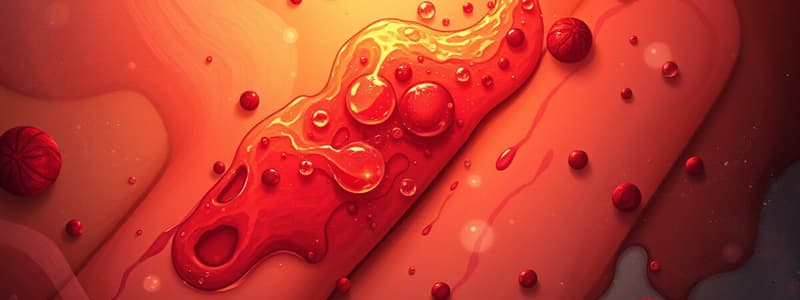Podcast
Questions and Answers
What condition is commonly referred to as eczema?
What condition is commonly referred to as eczema?
- Rosacea
- Acne
- Psoriasis
- Dermatitis (correct)
Which of the following is a characteristic of allergic contact dermatitis?
Which of the following is a characteristic of allergic contact dermatitis?
- Itching without rash
- Immediate reaction
- Spongiosis (correct)
- No need for patch testing
What is the diagnostic test of choice for allergic contact dermatitis?
What is the diagnostic test of choice for allergic contact dermatitis?
- Blood test
- Skin biopsy
- Patch testing (correct)
- Visual inspection
Which of the following treatments is recommended for irritant contact dermatitis?
Which of the following treatments is recommended for irritant contact dermatitis?
What primarily causes irritant contact dermatitis?
What primarily causes irritant contact dermatitis?
What is considered the hallmark symptom of atopic dermatitis?
What is considered the hallmark symptom of atopic dermatitis?
In which areas is atopic dermatitis commonly found in infants?
In which areas is atopic dermatitis commonly found in infants?
Which of the following is NOT a minor feature of atopic dermatitis?
Which of the following is NOT a minor feature of atopic dermatitis?
What is important for patients to understand about atopic dermatitis treatment?
What is important for patients to understand about atopic dermatitis treatment?
What is the main characteristic of seborrheic dermatitis management?
What is the main characteristic of seborrheic dermatitis management?
What is a common characteristic of nummular dermatitis?
What is a common characteristic of nummular dermatitis?
Which treatment is considered the mainstay for managing nummular dermatitis?
Which treatment is considered the mainstay for managing nummular dermatitis?
Which factor is associated with a higher incidence of seborrheic dermatitis?
Which factor is associated with a higher incidence of seborrheic dermatitis?
What should patients be aware of regarding the treatment of nummular dermatitis?
What should patients be aware of regarding the treatment of nummular dermatitis?
What is the hallmark symptom of Lichen Simplex Chronicus and Prurigo Nodularis?
What is the hallmark symptom of Lichen Simplex Chronicus and Prurigo Nodularis?
What physical change may be observed in Lichen Simplex Chronicus?
What physical change may be observed in Lichen Simplex Chronicus?
What triggers Prurigo Nodularis?
What triggers Prurigo Nodularis?
Which characteristics can be seen in Lichen Simplex Chronicus?
Which characteristics can be seen in Lichen Simplex Chronicus?
What is an important management strategy for both Lichen Simplex Chronicus and Prurigo Nodularis?
What is an important management strategy for both Lichen Simplex Chronicus and Prurigo Nodularis?
What is a significant treatment approach for dyshidrotic dermatitis?
What is a significant treatment approach for dyshidrotic dermatitis?
Which early sign is associated with stasis dermatitis?
Which early sign is associated with stasis dermatitis?
Which condition is most commonly linked with dyshidrotic dermatitis?
Which condition is most commonly linked with dyshidrotic dermatitis?
Which of the following is a late sign of stasis dermatitis?
Which of the following is a late sign of stasis dermatitis?
What type of fluid is typically found in the blisters of dyshidrotic dermatitis?
What type of fluid is typically found in the blisters of dyshidrotic dermatitis?
What is the most common cause of xerotic dermatitis?
What is the most common cause of xerotic dermatitis?
Which symptom distinguishes xerotic dermatitis from general dry skin?
Which symptom distinguishes xerotic dermatitis from general dry skin?
Where in the body does xerotic dermatitis typically first arise?
Where in the body does xerotic dermatitis typically first arise?
What is an effective management strategy for xerotic dermatitis?
What is an effective management strategy for xerotic dermatitis?
What treatment is recommended for clearing xerotic dermatitis?
What treatment is recommended for clearing xerotic dermatitis?
Flashcards are hidden until you start studying
Study Notes
Dermatitis Overview
- Dermatitis, commonly known as eczema, involves inflammatory disruption of the epidermis.
- Treatment primarily consists of emollients and corticosteroids.
- Impaired barrier function of the skin leads to increased transepidermal water loss, exacerbating symptoms.
Types of Dermatitis
Contact Dermatitis
- Most prevalent type of dermatitis.
Allergic Contact Dermatitis
- Spongiosis is frequently observed.
- Involves calcineurin inhibitors for treatment.
- Mediated by a type IV delayed hypersensitivity reaction, triggered by skin contact with allergens.
- Patch testing is the preferred diagnostic method.
- Main treatment strategy is allergen avoidance.
Irritant Contact Dermatitis
- Patients can often self-diagnose.
- Initiates with keratinocyte damage that releases signals attracting inflammatory cells.
- Commonly worsened by wet-to-dry cycling, especially during cold seasons.
- Emollients are effective in promoting recovery.
- Hardening of the skin occurs through repeated exposure.
Treatment Strategies
- Avoidance of irritants and allergens is crucial in managing contact dermatitis.
- Topical glucocorticoids are recommended for inflamed or irritated areas of the skin.
- Emollients significantly aid in skin recovery.
- Oral antihistamines may be used to alleviate symptoms.
Dermatitis Overview
- Dermatitis, commonly known as eczema, involves inflammatory disruption of the epidermis.
- Treatment primarily consists of emollients and corticosteroids.
- Impaired barrier function of the skin leads to increased transepidermal water loss, exacerbating symptoms.
Types of Dermatitis
Contact Dermatitis
- Most prevalent type of dermatitis.
Allergic Contact Dermatitis
- Spongiosis is frequently observed.
- Involves calcineurin inhibitors for treatment.
- Mediated by a type IV delayed hypersensitivity reaction, triggered by skin contact with allergens.
- Patch testing is the preferred diagnostic method.
- Main treatment strategy is allergen avoidance.
Irritant Contact Dermatitis
- Patients can often self-diagnose.
- Initiates with keratinocyte damage that releases signals attracting inflammatory cells.
- Commonly worsened by wet-to-dry cycling, especially during cold seasons.
- Emollients are effective in promoting recovery.
- Hardening of the skin occurs through repeated exposure.
Treatment Strategies
- Avoidance of irritants and allergens is crucial in managing contact dermatitis.
- Topical glucocorticoids are recommended for inflamed or irritated areas of the skin.
- Emollients significantly aid in skin recovery.
- Oral antihistamines may be used to alleviate symptoms.
Atopic Dermatitis Overview
- Commonly referred to as skin asthma, characterized primarily by intense itching (pruritus).
- Often leads to a cycle of scratching and subsequent rash formation.
Major Features
- "The Itch that Rashes" is a descriptor for the condition.
- In infants, lesions typically appear on the face and extensor surfaces.
- In young children and adults, dermatitis is more common in the flexural areas (e.g., behind the knees, inside elbows).
Minor Features
- Keratosis pilaris: Noted as "chicken skin," presenting on the arms, medial thighs, back, and potentially on an infant's face.
- Pityriasis Alba: A common skin condition presenting with hypopigmented patches.
Treatment and Management
- No permanent cure exists for atopic dermatitis; management focuses on symptom relief.
- Patient education is critical to dispel fears and misconceptions about the condition.
- Proper bathing techniques are encouraged to help manage symptoms and maintain skin moisture.
Seborrheic Dermatitis
- Affects individuals of all ages globally.
- Incidence is higher in HIV-positive patients.
- Moisturizers are essential for treatment.
- Anti-inflammatory therapies include:
- Topical steroids (most commonly used).
- Calcineurin inhibitors as an alternative treatment.
- Important for patients to understand that seborrheic dermatitis can be managed but not cured.
- Long-term management strategies do not provide a permanent solution.
- Antifungal medications may also be utilized for treatment.
Nummular Dermatitis
- Also known as discoid eczema.
- Characterized by coin-shaped plaques formed from papules and papulo-vesicles.
- Pathogenesis is multifactorial, with various contributing factors.
- Generalized form can arise from exposure to allergens via oral or topical routes.
- Emotional stress is recognized as a significant trigger for outbreaks.
- Patients should be aware that no permanent cure exists for nummular dermatitis.
- Treatment primarily involves topical corticosteroids.
- Additional treatment options include:
- Topical calcineurin inhibitors as secondary treatments.
- Tar preparations.
- Emollients for associated dryness (xerosis).
- Oral steroids may be prescribed for severe cases.
Lichen Simplex Chronicus (LSC) and Prurigo Nodularis (PN)
- Secondary lesions often associated with LSC and PN, characterized by severe itching.
- Emotional and psychological factors play a significant role in the development of both conditions.
Lichen Simplex Chronicus
- Presents with radial thickening of the skin.
- Hyperpigmentation and hypopigmentation may occur, indicating changes in skin color.
- Commonly affects areas that are easily reachable for scratching.
Prurigo Nodularis
- Results from repetitive picking and scratching, often linked to underlying psychological disorders.
- Lesions are firm to hard upon palpation and vary in size from 0.5 cm to greater than 3.0 cm.
Management Strategies
- Essential to avoid scratching; cessation of scratching leads to resolution of rashes.
- Both conditions typically follow a chronic course, with symptoms persisting or recurring over time.
- Treatment focuses on breaking the itch-scratch cycle to alleviate symptoms.
Dyshidrotic Dermatitis
- Also known as Pompholyx, characterized by larger blisters and recurrent vesicular hand dermatitis.
- Blisters contain clear fluid and are often associated with a history of atopic dermatitis in patients.
- Management involves topical and systemic corticosteroids, as well as emollients.
Stasis Dermatitis
- Also referred to as gravitational dermatitis, varicose eczema, or congestion eczema.
- Commonly affects the elderly, primarily localized in the lower extremities, especially the medial supramalleolar regions.
- Can be an early indicator of chronic venous insufficiency.
Peripheral Venous Spectrum
- EARLY SIGNS:
- Tenderness and discomfort in affected areas.
- Cushion-like pitting edema.
- Hyperpigmentation indicating changes in skin color.
- LATE SIGNS:
- Atrophie blanche, presenting as white, atrophic patches on the skin.
- Lipodermatosclerosis, involving skin hardening and inflammation.
- Appearance resembling an inverted wine bottle.
- Venous ulcers, which are open sores due to poor venous circulation.
Xerotic Dermatitis Overview
- Also known as eczema craquelé, winter eczema, winter itch, and desiccation.
- Another term is xerosis, indicating very dry skin.
- May also be referred to as asteatosis or asteatotic eczema.
Causes and Symptoms
- Most commonly caused by aging, particularly in individuals over 60 years.
- Initially appears on the shins, typically on the anterior side.
- Symptoms include stinging sensations, especially when more advanced as eczema.
- Dry skin alone is insufficient for diagnosis; it must be accompanied by itching and stinging.
- Skin texture may become rough and exhibit “pseudo-ichthyosis,” resembling fish-like skin.
Management Strategies
- For xerosis (dry skin), regular application of emollients is recommended.
- Xerotic dermatitis can often clear up within a few days when treated with topical corticosteroid ointments.
Studying That Suits You
Use AI to generate personalized quizzes and flashcards to suit your learning preferences.




